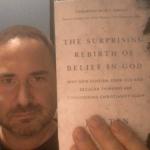
A subject I have addressed in previous articles is the concept of “Religious Trauma,” also called “Spiritual Abuse,” or “Church Hurt.” However, in those previous articles, I had not done any investigation into the formal academic literature on the subject. This was in part because I had not yet gotten to the point in my deconversion research that I was ready to tackle a tangential topic*. But it was also in part because there was practically no peer-reviewed research on the subject from reputable sources. The term and most of the material available on the topic had come from those who self-diagnosed as having this mental-health issue, or from informal self-help books written on the subject.
However, in this article, I look at three peer-reviewed articles from reputable publications that I was finally able to find on this subject.
The terms Religious Trauma, Spiritual Abuse, and Church Hurt, while widely floated in the “Deconstruction Movement” (Oostveen, 2018), as well as various movements intended to restructure the cultural approach to religion and spirituality (McLaren, 2022), are not so widely reflected in the literature.
The term “Religious Trauma Syndrome” was originally coined in the book Leaving the Fold by Marlene Winell (2007). Originally published in the 90’s, this self-help book received relatively little attention at the time, but has since been revised, reprinted, and become a best seller, with its author becoming a very visible spokesperson on the topic. Winell and others outside of academic psychology have framed Religious Trauma as another pathway of abuse along with sexual, verbal, and physical abuse, with resulting symptoms similar to PTSD (Winell & Allen, 2007).
Yet despite its extensive usage in the pop-psychology sphere, “Religious Trauma” has received relatively little formal academic study (Downie, 2022). Downie (2022) suggests that religious trauma is far more prevalent than the literature suggests, and ought to become the subject of far more academic attention than it currently receives. In her essay on the topic, Ramler (2023) offers her own experience of religious trauma, deconversion, and the fallout following this event as evidence of the need for further work in the field, and calls for an expansion of the rhetoric related to the concept of religious trauma, which currently appears to be relegated to online forums and support groups, but is almost entirely absent from academic discourse.
Downie’s (2022) work on religious trauma was done in the form of a literature review, and, like Ramler (2023), draws somewhat on her own experiences. While Ramler (2023) suggests a radical shift in the rhetoric surrounding trauma psychology to include religion as a source of trauma, Downie (2022) simply suggests caution in the terminology used by academics to categorize this phenomenon. Primarily, she suggests that researchers frame the problem in terms of “religion” rather than “spiritual” (as with the term “spiritual abuse”). Religion, while a somewhat fluid term, still has the potential to be more measurable and empirical than “spiritual.”
Downie (2022) suggests that religious trauma is characterized by a gradual building as specific religious ideas are internalized. She identifies the period of time at which people are most susceptible to these ideas as youth or early childhood. Further, Downie (2022) suggests that one characteristic of religious ideas which are liable to traumatize involves the breaking things into the binary categories of “good” and “bad,” with all of the things in the “bad” category being roundly condemned. She says that this can affect a person in two realms: the emotional realm with feelings of guilt, anxiety, and depression; and in the realm of the intellect, resulting in poorly nuanced, black-and-white thinking, and a loss of creativity. Interestingly, another group of researchers (Harris et al., 2007) accuse the psychological community of a lack of nuanced and creative thinking when it comes to the relationship between religion and mental health. They conclude their study by saying that the question is not whether religion is good or bad for mental health, but rather, which aspects of religion are good and which are bad?
Helpfully, Downie identifies the functional conditions of an environment leading to Religious Trauma. Specifically, any environment which places things in rigid binaries, absolutes, and reactionary or proactive condemnatory attitudes. Presumably any environment containing these features could lead to Religious Trauma, even if the environment isn’t specifically centered around spiritual ideas.
In a complimentary finding, Harris et al. (2007) cite research that some religious environments are statistically associated with elevated wellbeing across a variety of metrics, whereas other types of religious environments are statistically associated with higher levels of mental illness, especially those they describe as “more religious” (Harris et al., 2007). “More religious” for Harris et al. may map onto the condemnatory, binary thinking identified by Downie.
Harris et al. (2007) did their study on the two outcomes religious functioning may have in relationship to trauma: recovery and growth on the one hand, and further traumatization on the other. When a person experiences trauma as a response to religious functioning, notes Harris et al., this will frequently result in the person exiting their religion entirely. This is reinforced by the essay by Ramler (2023), whose experience of trauma (discovering that her youth pastor had been sexually assaulting her peers) eventually led to her own exit from the church (Ramler, 2023).
Downie (2022) argues that this environmental trauma is liable to shape the person’s nervous system and views such that exiting the religious environment would not remove the effects of the trauma from the person’s life, and they would continue to experience the world through the lens of that trauma. These effects, says Downie, may potentially be lifelong.
More than mere neurology, Downie suggests that if a person’s way of knowing or understanding the world around him or her is done through a religious lens which limits the person’s ability to recognize circumstances in which he or she has been harmed, then the person could continue to undergo actual abuses without recognizing them as abuse (such as being shamed or belittled when one is taught one deserves shame and belittling for spiritual reasons). This is similar to the findings of Harris et al. (2007) that identifying trauma as direct judgment from God or as coming from the devil results in negative coping.
This “religion as a way of knowing” critique is echoed in the essay of Ramler (2023), who identified in her own deconversion that the religious lens through which she had been taught to view the world resulted in “epistemic uncertainty,” meaning she did not know how to understand the world outside of the religious context in which she was raised.
Downie does acknowledge, however, what has been long recognized by psychologists since the turn of the century: that religion has potentially positive psychological benefits (Kloos et al., 1995). Similarly, Harris et al. (2007), acknowledge that religion has been shown to be an effective method of overcoming trauma and regaining mental and emotional stability on the other side. But, Downie argues, the mode in which religion is practiced could result in harmful thinking if one uses one’s religious thinking to deny or bypass problems rather than to find resolution or peace in the face of difficulty (Downie, 2022). This is complimented by the work of Harris et al. (2007), which suggests that prayers which defer or bypass trauma can lead to negative coping.
Downie describes that “shame” is a bodily rather than a mental experience. Further, Downie recognizes that shame can be an effective and non-damaging method of shaping behavior within the context of a secure relationship (as when a parent calls attention to a child’s destructive behavior, and the child feels shame recognizing that she ought to have behaved differently). But within the context of an insecure relationship – as with a church environment which might ostracize a person of whom they disapprove, shame can be traumatizing and emotionally harmful (Downie, 2022). Because shame is physiological rather than psychological, once a person has been conditioned by one’s religious environment to feel shame, those feelings may perpetuate outside of the religious environment.
Downie suggests that the theme of guilt is built into Christian theology. Guilt, in this context, is defined as being responsible for wrongdoing. However, in certain religious environments, the concept of guilt (a volitional category) has been entangled with the concept of shame (an emotional category), such that Christian theology becomes inherently shame-inducing under this approach (Downie, 2022). Harris et al. (2007) similarly identified guilt associated with failures in virtue as one of their 5 negative aspects of religious involvement. They noted that those aspects were associated with higher levels of depression and suicidality.
Downie resolves the problem by concluding that the treatment for religious abuse through shame is to use religion to create something new and different in place of shame, and suggests that theologians take the research on Religious Abuse into account as they develop their discipline (Downie, 2022).
Harris et al. (2007) did their research on the interaction between a person’s religion and that person’s experience of trauma. This does not necessarily refer to trauma experienced within a religious context, but trauma in general. One such interaction is the cognitive dissonance one experiences when one cannot reconcile one’s experience of trauma with the idea of a good, loving, and benevolent God.
Harris et al. (2007) identified 10 religious coping strategies which could be classified as “positive” in terms of overcoming trauma and building resilience, and 6 strategies associated with “negative” outcomes. The negative strategies include reduced satisfaction in one’s relationship with God, the clergy, or one’s faith group, attribution of the stressor to Satan, an external locus of control (waiting for God to fix the problem), identifying God as less than omnipotent, identifying the problem as direct punishment from God, and praying for a miracle or intercession.
Harris et al. (2007) found that individuals experiencing the negative effects of religious coping were more likely to seek out psychological solutions such as counseling or therapy.
The research of Harris et al. (2007) was a quantitative study with a sample of 327 participants who were administered a battery of questionnaires related to trauma and religious coping. What they found was that there were two post-traumatic paths one could pursue in relationship to one’s religion, with the one (Seeking Spiritual Support) related to posttraumatic growth (although not a reduction of posttraumatic symptoms) and the other (Religious Strain) related to posttraumatic symptoms but had no relationship (positive or negative) to post-traumatic growth.
Gaps in the Literature
As noted by Downie and Ramler, the literature surrounding religious trauma is still very scarce, with the work of Harris et al. (2007), being the only prominent quantitative study on the subject, and not directly related to religion-as-source-of-trauma. The work on religious trauma seems to be dominated by those who claim to have experienced the trauma, largely restricting the findings to the realm of critical theory, with very little in the way of empirical research on the topic. The literature I was able to find which was not included in this review was dominated by work done on religious trauma related to sexual orientation, and the essay by Ramler (2023) placed her status as a queer POC at the center of her thesis. Consequently, it is difficult to tell whether the bulk of the academic work on the topic is related to sex, gender, and race theories, or if sex, gender, and race are the primary factors suffering from religious trauma. This appears to be a field ripe for research from a multidisciplinary perspective.
*The idea that Religious Trauma Syndrome is a tangential topic to deconversion is based largely on the fact that the Syndrome tends to be reported by those who have already exited their church or faith. This makes it difficult to determine if the syndrome, whatever it may be, is responsible for the exit, or is a consequence of the exit. This is part of what makes this worth its own investigation rather than lumping it in with deconversion studies as a whole.
References
Downie, A. (2022). Christian shame and religious trauma. Religions, 13(10), 925. https://doi.org/10.3390/rel13100925
Harris, J. I., Erbes, C. R., Engdahl, B. E., Olson, R. H., Winskowski, A. M., & McMahill, J. (2007). Christian religious functioning and trauma outcomes. Journal of Clinical Psychology, 64(1), 17–29. https://doi.org/10.1002/jclp.20427
Kloos, B., Horneffer, K., & Moore, T. (1995). Before the beginning: Religious leaders’ perceptions of the possibility for mutually beneficial collaboration with psychologists. Journal of Community Psychology, 23(4), 275–291. https://doi.org/10.1002/1520-6629(199510)23:4<275::aid-jcop2290230402>3.0.co;2-u
McLaren, B. D. (2022). Faith after doubt: Why your beliefs stopped working and what to do about it. Hodder & Stoughton.
Oostveen, D. F. (2018). Multiple religious belonging and the ‘deconstruction’ of religion. Exchange, 47(1), 39–52. https://doi.org/10.1163/1572543x-12341466
Ramler, M. E. (2023). When god hurts: The rhetoric of religious trauma as epistemic pain. Rhetoric Society Quarterly, 53(2), 202–216. https://doi.org/10.1080/02773945.2022.2129755
Winell, M., & Allen, S. (2007). Leaving the fold: A guide for former fundamentalists and others leaving their religion. The Apocryphile Press.


















